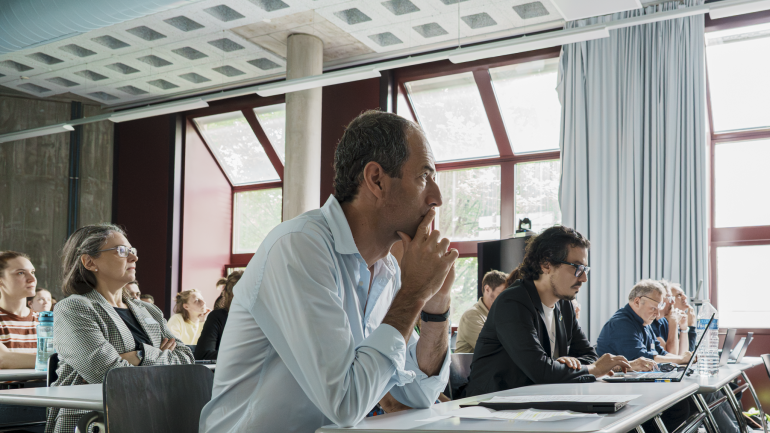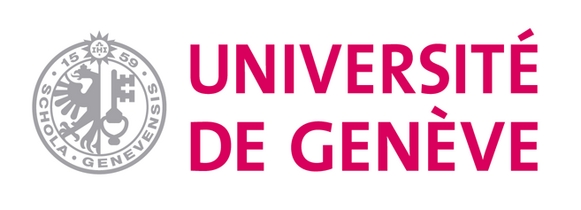
Life course researchers presented their work at the annual LIVES Day» in Lausanne on June 3, 2025. Photos/video: © Centre LIVES
What a pace! 34 five-minute presentations, 2 fifteen-minute keynotes, with 80 participants discussing topics ranging from new family practices in Switzerland and equal opportunities in education to end-of-life preparation and perinatal grief. The latest «LIVES Day» confirmed not only the importance of bringing together researchers specializing in the life course, but also their enjoyment of doing so. Listening to colleagues’ research, blending disciplines and methods—the event was rich and vibrant. Proof of its relevance: even more participants registered this year, and none dropped out. Laure Sandoz, scientific coordinator of the LIVES Centre and organizer of the event, explains the purpose of LIVES Day.
What is the goal of «LIVES Day»?
To bring together people working on the life course. To provide an overview of the projects currently associated with LIVES through flash presentations (5 minutes). Each year, we aim for a varied program that encourages our members to attend and find out what’s happening within the Centre. We hope that this event will help scientists to identify colleagues working on similar topics, spark discussions and, who knows, lead to new collaborations.
How many years has LIVES Day been organized?
In its current format, this is the third time we’ve held the event since the end of the National Centre of Competence in Research. However, there has always been a major annual gathering for all LIVES members for the past 15 years.
Are people satisfied with these events?
It’s encouraging to see that almost all of the scientists we contact to present their research accept the invitation each year. We always have a strong turnout from the audience. This year, we had nearly 80 participants, which reassures us that we should continue organizing this event.
Are there both work and social components?
That’s the idea, really. It’s important to have a convivial moment after the scientific part. It gives people the chance to connect and talk. Every year, we hope for good weather for the outdoor aperitif… This year, we were lucky again, because it’s definitely less fun to move into a cafeteria. Sometimes, we have funny experience and see people in a different light. I remember one particularly hot year… People jumped into the lake!
How many members does the LIVES Centre currently have?
We currently have over 280 members, spread across Lausanne, Geneva and other higher education institutions in Switzerland and abroad.
Is that a satisfactory number?
Yes. Within the coordination team, we get to know the active members quite well. So, when we organize events such as LIVES Day, there’s a critical mass of people, yet the event still feels relatively intimate. Our goal isn’t necessarily to have a large number of members, but rather to have engaged ones.
Engaged members, you say. Are there any disengaged members?
Our aim is to bring together members with shared interests, even if they come from different backgrounds. The key word is interdisciplinarity. We encourage collaboration between people interested in other disciplines and research methods. To encourage this exchange, we occasionally ask our members to get involved—participate in conferences, propose events, help organize workshops. Sometimes, we invite them to teach in our doctoral program. We don’t want members who are solely focused on their own research. We expect them to keep the idea of community exchange in mind.
Interdisciplinarity—why is it so important?
I think there’s this idea that science has become very compartmentalized. We’ve become increasingly specialized in specific topics. Departments and institutes also operate in a very disciplinary way, which allows for important specialization. But I think we’ve now reached a point where we realize that to innovate and be creative, it’s also important to see what’s being done elsewhere. Sometimes, there’s a tendency to repeat the same things. So, crossing disciplines and bringing scientists together can spark new ideas, generate new knowledge, and prevent the duplication of similar discoveries in parallel silos.
Can you give an example of interdisciplinarity that aligns with your goals?
The research on centenarians—«SWISS100 – Investigating Vulnerability and Resilience in Swiss Centenarians»—whose results were presented last May, is a recent example. Combining specialties such as biology, psychology, psychiatry, clinical medicine, and sociology enables us to grasp the phenomenon as a whole, offering social, clinical, and psychological insights that can inform understanding and action if needed.
What are the benefits of being a LIVES member?
We mainly offer a community, a network, and opportunities for exchange, meetings, and conferences. We bring scientists together around the theme of the life course, enabling them to stay informed about each other’s work, and broaden their horizons. LIVES also supports the next generation. Our doctoral program and our grants for young researchers are good examples. While the amounts aren’t huge, they are appreciated. It’s important to emphasize again that we offer an interdisciplinary working environment to advance research on the life course and vulnerability.
Interview by Kalina Anguelova

